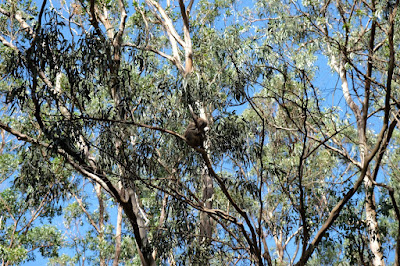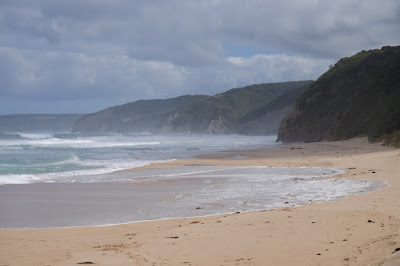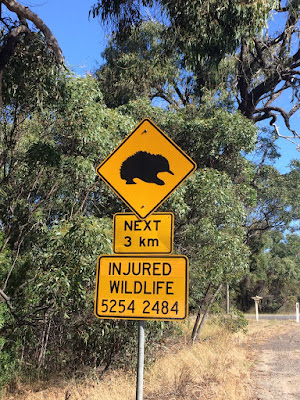The Great Ocean Road is one of Australia’s most well-known scenic drives. Officially running along the southern mainland coast from Torquay to Port Fairy, the route includes 413 miles (664 kilometers) of beautiful beaches, world-class surf spots, small towns, and landmarks. We packed up in Melbourne with no reservations along the way, planning just to spend 4 days and 3 nights driving the route and overnighting wherever we felt like.
Before heading out on the Great Ocean Road, we first stopped by Westgate Park in Melbourne. We'd read a NYT article about a salt lake that turns pink due to the interaction of a green alga and a bacteria in response to high levels of salt in the water. It was pretty surreal looking! The phenomenon only happens in a handful of lakes around the world, apparently.
After that it was time to hit the road! The drive from Melbourne to Torquay was fast and easy, and we had a picnic on a grassy slope while watching surfers. This group was primarily people learning how to surf, so we watched a lot of short rides and spills.
We drove further on to Bells Beach, which is an internationally famous surf spot. The Rip Curl Pro is held at Bells Beach around Easter every year, and workers were setting up scaffolding and seating for the event while we were there. We watched much more advanced surfers taking on some incredibly large and powerful waves.
In Anglesea, we stopped at a golf course that's home to a resident population of kangaroos. It was funny to watch them hopping all over the green and through the sand traps.
Split Point was another scenic stop, where we admired both the lighthouse and the views of the ocean.
We'd already been on the Great Ocean Road for a bit when we passed through this landmark and stopped to take both a picture of it and the windy coastal road.
We stopped for the night in Apollo Bay, where we walked on the beach, took our Day 270 photo, and ate dinner at a local pub with home-brewed beer and a playground across the street (always a win-win combination for this family). The next morning, we continued west and stopped first in Great Otway National Park for a short walk through the rainforest.
The trees were enormous! They reminded us of the sequoias in northern California, USA.
After our short hike, we continued deeper into Great Otway National Park and found wild koalas! We pulled off the road several times as we spotted them high above us in the eucalyptus trees. Seeing koalas at the Conservation Centre on Phillip Island was nice, but finding then in the wild was much better.
One of the koalas was even awake and eating! We watched him stuffing eucalyptus leaves in his mouth just feet from where we were standing.
We ended the day with a walk along at the beach at Gibson Steps, with the wind whipping up waves that crashed just before reaching the towering cliffs on the shore.
We spent the night only a few kilometers from the Twelve Apostles, which is a collection of limestone stacks reaching high out of the ocean in Port Campbell National Park. Over millions and millions of years, the elements wore down the limestone coastal cliffs, forming caves (like those we saw in Yangshuo, China, karsts (like those in Halong Bay, Vietnam), then arches, then stacks as erosion claimed more and more of the limestone. While originally there may have been twelve apostles, today there are only eight. The last stack (the previous ninth apostle) collapsed in 2005.
We went to the Twelve Apostles for sunrise but unfortunately it was raining, so we didn't see any beautiful colors in the sky.
We could eventually see the sun peeking out further away, though.
Later in the day, we went back to the same spot for a few sunnier pictures.
Driving on, we stopped at Loch Ard Gorge, where waves thundered in through a narrow opening in the rock.
Down at beach level, Colin was keen to watch the wave from this rock......every so often a big wave came though that completely surrounded the rock with water.
The waves were incredibly powerful. It was easy to get lulled into a false sense of security on the beach, but every so often a monster wave would come through and flood almost the whole area.
We also stopped briefly to see the London Arch, another natural formation off the coast. There used to be a land bridge between the two sections of rock, and tourists could walk out to the arch portion. In 1990 the bridge collapsed, much to the surprise of the tourists who happened to be out there at the time. Fortunately nobody was hurt in the collapse, and the stranded tourists earned a free helicopter ride off the rock and a whopper of a travel story.
Further down the road, we saw something crossing the pavement and realized it was an echidna! Sometimes known as spiny anteaters, they are native to Australia but can hard to spot in the wild (just like the platypus in Tasmania that we were lucky enough to find). We pulled off and watched this guy for a bit.....guess the animals pictured on the road signs do actually exist somewhere!
From there we arrived in Port Fairy, which is technically the end of the Great Ocean Road. We continued driving west, enjoying a few more scenic views and small towns before leaving the state of Victoria and passing into the state of South Australia (SA). We had to stop to throw out a few fresh fruits and vegetables just after the state border--it's been interesting to see how different states in Australia have varying restrictions on what can and can not be brought in/out. Tasmania has been the strictest so far (with fruit-sniffing dogs patrolling at the airport when we arrived), but this roadside quarantine trash bin was also something new to see.
We arrived in Mount Gambier, our final overnight stop, with a bit of time left in the day to explore. We walked through the Valley Lake Wildlife Park, where we spotted more wild koalas and kangaroos.
This guy is even lounging like the museum kangaroo in Launceston!
We stopped by the Umpherston Sinkhole, which was turned into a sunken garden back in 1886. The gardens were pretty and lush.
What we really went for was to see and feed the possums that come out in the sinkhole in the evenings. Where Bob and I both grew up, possums are nasty creatures that you don't go anywhere near (if they're even alive, most of them seem to be born dead on the side of the road). However, the hotel owner assured us that these possums were disease-free and friendly, and the kids were excited to hand feed them.
The next morning we went back to the park to try and get a good view of Blue Lake, Mount Gambier's crater lake that, on sunny days, looks like this:
We thought the Blue Lake would be a nice complement to the Pink Lake that we saw back in Melbourne... due to overcast weather, however, the lake was not vibrantly blue. But it was still pretty.
From Mount Gambier, we said goodbye to the beautiful southern coast of Australia and headed on towards Adelaide!




















































No comments:
Post a Comment